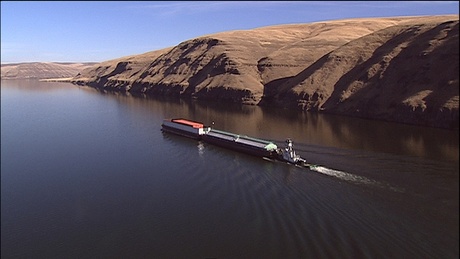forum
library
tutorial
contact

U.S. Army Corp of Engineers
Prepares Snake River Dredging Plans
by Aaron Kunz
Northwest Public Radio, April 8, 2013
|
the film forum library tutorial contact |

|
U.S. Army Corp of Engineers
by Aaron Kunz
|
 The U.S. Army Corp of Engineers wants to dredge a deeper channel for barges in the waters behind southeastern Washington's Lower Granite Dam. Idaho's Port of Lewiston says the work is important to keep the local economy moving. But as EarthFix reporter Aaron Kunz explains, some environmental groups opposed to the plan.
The U.S. Army Corp of Engineers wants to dredge a deeper channel for barges in the waters behind southeastern Washington's Lower Granite Dam. Idaho's Port of Lewiston says the work is important to keep the local economy moving. But as EarthFix reporter Aaron Kunz explains, some environmental groups opposed to the plan.
Damming the lower Snake River in southeastern Washington has turned the nearby town of Lewiston, Idaho into the Northwest's most inland seaport. But the build-up of sediment is making the water too shallow for barges to navigate the waters behind the Lower Granite Dam.
The U.S. Army Corps of Engineers has a plan to use heavy machinery to dig up sediment collecting on the bottom of the dam-created Lower Granite Lake, where the depth is as shallow as seven feet. The corps wants a shipping channel that's 14 feet deep and 250 feet wide.
It needs $39 million from Congress and has to meet environmental requirements before it can start work.
Bruce Henrickson is a spokesman for the Corps. He says the work can't wait. And that alternatives -- like raising levees -- are not on the table.
Henrickson: "Right now there is an immediate need action trigger that we've reached and the only proven effective short term solution we've identified is the dredging."
Idaho Rivers United based in Boise is against dredging. Kevin Lewis says digging up the river bottom creates plumes of dirt and rocks that are dangerous to fish and other species. Dredging could also stir up other pollutants that have settled on the river bottom over many years.
Lewis: "The collateral damage of barging is the decimation of our native salmon and steelhead species."
Lewis says it's time for the corps to stop dredging its way out of problems created by the dams on the lower Snake River. Instead, more grain and other goods should be shipped by trains and trucks.
Lewis: "Dredging to maintain what we see as an obsolete form of transport, a barging system on the river is really an endless task. They'll have to be dredging forever and we don't think that's really sustainable."
Henrickson with the U.S. Army Corps of Engineers says barging has an environmental edge over other transportation modes.
Henrickson: "I can tell you that barging is an efficient,and less polluting way to transport cargo."
He says a single barge carries as much freight as 35 rail cars or 100 trucks on the highway -- but moving that barge requires less fuel and emits less pollution.
(bluefish notes: ACOE's suggestion that barging "requires less fuel" is unsubstantiated. Discussion with Bruce Henrickson confirms that this statement neglects the energy that lock flushes use up and that barge operators do not pay for -- about $1 million per year on the Lower Snake River. See also Relate Page below).Related Pages:
learn more on topics covered in the film
see the video
read the script
learn the songs
discussion forum
